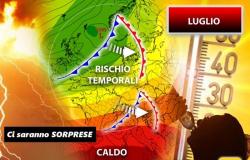Today is the thirtieth World Day to Fight Desertification, but based on the most updated data (2019) provided today by ISPRA, there is very little to celebrate in Italy.
«17.4% of the national surface is in a state of degradation», certifies the Higher Institute for Environmental Protection and Research, which calculated this data using the main UN sector indicators, i.e. the state and trend of coverage soil, productivity and organic carbon content.
«In Italy the territory shows clear signs of degradation – argues Ispra – which manifests itself in different forms, from erosion to salinisation, from compaction to contamination and waterproofing».
Land degradation and desertification – which represents its most serious level – are advancing throughout the world, aggravated by the effects of climate change on soil already heavily compromised by unsustainable use.
In this way, the essential services for human life that the soil offers are put at risk, primarily agricultural production, but also the ability to contain water courses and contribute to the management of water resources and to permanently conserve excess CO2.
«Up to 40% of the world’s territory is already degraded, affecting almost half of humanity – explains Ibrahim Thiaw, executive secretary of the UN Convention to combat desertification (UNCCD) – Yet solutions are on the table. Land restoration lifts people out of poverty and strengthens resilience to climate change. It’s time to unite for the land and show the red card to land loss and degradation around the world.”
It is no coincidence that today the Council of the EU definitively adopted the European law for the restoration of nature; paradoxically, however, the Meloni Government remained in the minority of countries against it. Formally, the criticisms leveled by the national executive against the European law focus on the negative effects it would have on the agricultural world, but in reality the opposite is true.
As documented by a new study conducted by Greenpeace together with sector experts, the climate and biodiversity crisis is the main risk for Italian crops.
It is enough to observe the data on the trend of rainfall and temperatures, which show an increasingly warmer Northern Italy, with a climate which is becoming tropicalised, and soil which is on average poorer in water in all Italian regions, especially in the South where the Drought puts crops that are fundamental to the Mediterranean diet at risk.
Over the last 40 years, at a national level, the increase in the average winter temperature (January-March) has been almost 1.5°C, with peaks of almost 2°C in the North West and over 1.5°C in the North East. The greatest increases were recorded in Valle d’Aosta, Piedmont and Lombardy. In just two months of winter 2024, approximately the same amount of water fell on Northern Italy as it rained in all three previous winters.
In the rest of the country, however, in the winters of 2021-2024 there was a general reduction in cumulative rainfall compared to the average of the thirty-year period 1981-2010: a variation that is larger in the South (-2.3%) and in the Islands (- 5.7%), where it affects areas already characterized by less rainfall than elsewhere.
«As regards the rainfall regime – Istat researchers Stefano Tersigni and Alessandro Cimbelli declared to Greenpeace – these are increasingly connected to very intense rainfall and extreme meteorological events which often cause floods and instabilities because the ground is unable to absorb rainfall so abundant and concentrated.”
As a result, the soils of all Italian regions (with the exception of Valle d’Aosta) are poorer in water than the average of the last 30 years. In particular Sicily, where the average value of water present in surface soils has dropped by more than 2% in the last four winters compared to those of the previous thirty years, or Puglia and Calabria which both record a drop of more than 1%. %. Apparently small numbers, but which according to experts are a wake-up call.
«On average, soil is able to retain around 27% of water, of which, generally, only half is available for plants, around 15% – argues Tommaso Gaifami, agronomist of the Italian Agroecology Association ( Aida) – Therefore, even the loss of just one percentage point is equivalent to a significant reduction in the water reservoir that plant roots can draw on. A deficiency which, in agricultural land, must be compensated through irrigation, with a greater use of water resources. It must also be considered that some techniques typical of intensive agricultural systems risk worsening this situation, leading to an impoverishment of the soil, while agroecological techniques and the inclusion of natural elements in agricultural areas can be an important ally for retaining moisture in the soil” .
The current situation indicates that the South and its agricultural sector are in particular difficulty, with consequent repercussions on the economy and the needs of the entire country: in fact, 99% of the areas cultivated with citrus fruits are found in the South and on the Islands, 81% of surfaces cultivated with olive trees intended for the production of oil and 73% of surfaces cultivated with durum wheat, used for the production of “made in Italy” pasta and bread.
«Climatic trends indicate that the soils of the Southern regions will be increasingly difficult to cultivate and that they cannot be compensated by the soils of Northern Italy, already intensively exploited, threatened by rapidly increasing average temperatures and increasingly extreme climatic events. more frequent – concludes Simona Savini, Greenpeace Italia Agriculture campaign – For this reason it is urgent and necessary to adapt our agri-food model to productions that require less water, starting from the reduction of land intended for animal feed».





